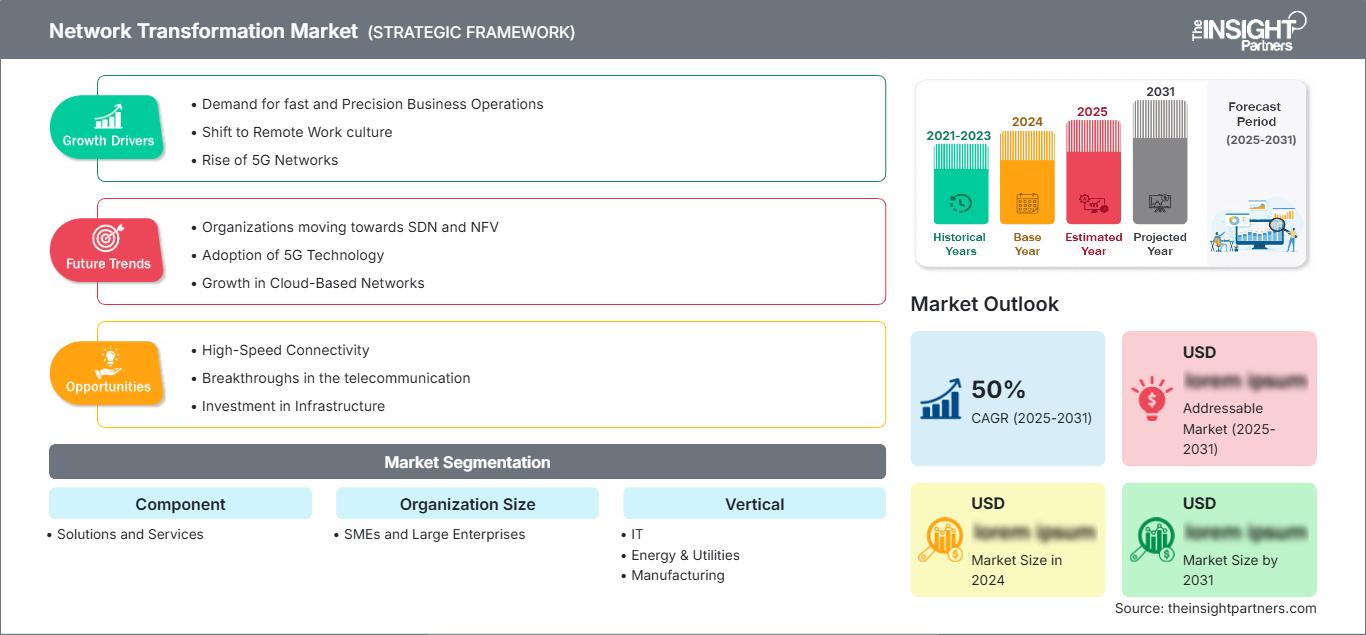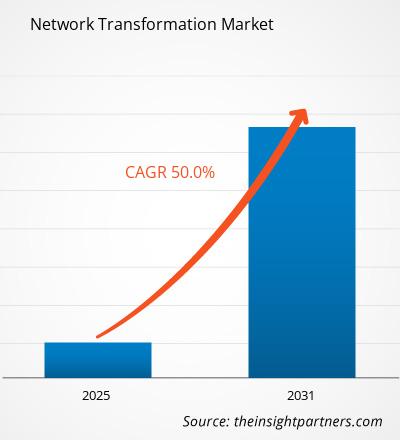Si prevede che il mercato della trasformazione di rete registrerà un CAGR del 50% dal 2025 al 2031, con una dimensione del mercato in espansione da XX milioni di dollari nel 2024 a XX milioni di dollari entro il 2031.
Il rapporto si concentra anche sul mercato della trasformazione di rete per tipologia, modello di distribuzione e regione. Questo mercato viene analizzato nella sua interezza da una prospettiva geografica per fornirgli una visione globale. Inoltre, sono state eseguite e presentate in questo rapporto un'analisi del mercato regionale e un'analisi per paese. Vengono inoltre fornite informazioni sul mercato in termini di valutazioni di mercato in dollari statunitensi (US$). In questo modo, i lettori saranno in grado di valutare il modello di crescita di ciascun segmento e di avere un'idea precisa della concorrenza presente sul mercato a livello globale.
Scopo del rapporto
Il rapporto "Network Transformation Market" di The Insight Partners mira a descrivere il panorama attuale e la crescita futura, i principali fattori trainanti, le sfide e le opportunità. Ciò fornirà spunti a vari stakeholder aziendali, come:
- Fornitori/produttori di tecnologia: per comprendere le dinamiche di mercato in evoluzione e conoscere le potenziali opportunità di crescita, consentendo loro di prendere decisioni strategiche informate.
- Investitori: per condurre un'analisi completa delle tendenze in merito al tasso di crescita del mercato, alle proiezioni finanziarie del mercato e alle opportunità esistenti lungo la catena del valore.
- Organismi di regolamentazione: per regolamentare le politiche e le attività di controllo nel mercato con l'obiettivo di ridurre al minimo gli abusi, preservare la fiducia degli investitori e sostenere l'integrità e la stabilità del mercato.
Componente di segmentazione del mercato della trasformazione della rete
- Soluzioni e servizi
Dimensione dell'organizzazione
- PMI e grandi imprese
Verticale
- IT
- Energia e servizi di pubblica utilità
- Produzione
- Media e intrattenimento
- Telecomunicazioni
Geografia
- Nord America
- Europa
- Asia-Pacifico
- America meridionale e centrale
- Medio Oriente e Africa
Potrai personalizzare gratuitamente qualsiasi rapporto, comprese parti di questo rapporto, o analisi a livello di paese, pacchetto dati Excel, oltre a usufruire di grandi offerte e sconti per start-up e università
Mercato della trasformazione della rete: Approfondimenti strategici

-
Ottieni le principali tendenze chiave del mercato di questo rapporto.Questo campione GRATUITO includerà l'analisi dei dati, che vanno dalle tendenze di mercato alle stime e alle previsioni.
Fattori di crescita del mercato della trasformazione di rete
- Richiesta di operazioni aziendali rapide e precise: il predominio delle iniziative di trasformazione digitale in tutti i settori più significativi ha intensificato l'urgenza di un aggiornamento delle infrastrutture legacy, che spinge un gran numero di organizzazioni a implementare soluzioni di rete di nuova generazione. Recenti sondaggi suggeriscono che quasi tutte le aziende (in media il 73%) si muoveranno per trasformare la dorsale di rete, aumentando ulteriormente la redditività del mercato.
- Passaggio alla cultura del lavoro da remoto: sulla scia del crescente passaggio dalle postazioni di lavoro tradizionali a una forza lavoro da remoto, nonché del cloud computing, la necessità di una rete solida non ha fatto che rafforzarsi, come dimostrano le crescenti tendenze del lavoro ibrido, poiché la maggior parte della forza lavoro globale (in media il 70%) è destinata a iniziare a lavorare in sede, dopo il graduale ritorno agli ambienti di lavoro in sede.
- Ascesa delle reti 5G: l'implementazione delle reti 5G è un fattore determinante per la trasformazione delle reti. La tecnologia 5G richiede una revisione completa delle architetture di rete esistenti, che porterà all'adozione di reti definite dal software (SDN) e virtualizzazione delle funzioni di rete (NFV) per abilitare l'infrastruttura scalabile e flessibile richiesta per i servizi 5G. Ciò sta accelerando la trasformazione dell'infrastruttura di rete a livello globale.
Trend futuri del mercato della trasformazione delle reti
- Le organizzazioni si stanno muovendo verso SDN e NFV: questa tendenza si sta spostando verso SDN e NFV, allontanando le organizzazioni dalle tradizionali reti basate su hardware. Le organizzazioni si stanno muovendo verso SDN e NFV per ottenere agilità, scalabilità ed economicità nella gestione delle reti.
- Adozione della tecnologia 5G: l'implementazione delle reti 5G sta imponendo la necessità di una trasformazione delle reti per consentire velocità più elevate, bassa latenza e connettività massiva per applicazioni come IoT ed edge computing.
- Crescita delle reti basate su cloud: per soddisfare la crescita degli ambienti ibridi e multi-cloud per una connettività senza interruzioni e prestazioni efficienti, le aziende sono costrette ad aggiornare le proprie reti.
Opportunità di mercato per la trasformazione delle reti
- Connettività ad alta velocità: il mercato della trasformazione delle reti è al centro delle esigenze insoddisfatte in vari settori che si affidano alla connettività ad alta velocità per migliorare il servizio e l'esperienza dei clienti; e trova ampia applicazione in diversi settori come sanità, finanza e commercio al dettaglio, tra gli altri.
- Svolte nelle telecomunicazioni: il settore delle telecomunicazioni, come l'avvento degli smartphone e l'imminente lancio del 5G insieme all'Internet of Things, ha anche creato nuove strade per i fornitori di servizi per continuare a innovare, abilitare una connettività mobile senza interruzioni ed espandere la portata delle applicazioni Internet of Things (IoT).
- Investimenti in infrastrutture: alcuni mercati in crescita hanno registrato un aumento degli investimenti in infrastrutture di rete, creando nuove opportunità di crescita per i principali attori e ampliando ulteriormente la quota di mercato. Un'analisi approfondita di questo mercato fornisce informazioni sulle aree strategiche per investimenti e opportunità di partnership, per aiutare gli stakeholder a capitalizzare le opportunità di crescita nella trasformazione delle reti.
Mercato della trasformazione della rete
Le tendenze e i fattori regionali che influenzano il mercato della trasformazione di rete durante il periodo di previsione sono stati ampiamente spiegati dagli analisti di The Insight Partners. Questa sezione illustra anche i segmenti e la geografia del mercato della trasformazione di rete in Nord America, Europa, Asia-Pacifico, Medio Oriente e Africa, America meridionale e centrale.
Ambito del rapporto di mercato sulla trasformazione della rete
Densità degli attori del mercato della trasformazione della rete: comprendere il suo impatto sulle dinamiche aziendali
Il mercato della trasformazione di rete è in rapida crescita, trainato dalla crescente domanda degli utenti finali, dovuta a fattori quali l'evoluzione delle preferenze dei consumatori, i progressi tecnologici e una maggiore consapevolezza dei vantaggi del prodotto. Con l'aumento della domanda, le aziende stanno ampliando la propria offerta, innovando per soddisfare le esigenze dei consumatori e sfruttando le tendenze emergenti, alimentando ulteriormente la crescita del mercato.

- Ottieni il Mercato della trasformazione della rete Panoramica dei principali attori chiave
Punti di forza
- Copertura completa: il rapporto copre in modo completo l'analisi di prodotti, servizi, tipologie e utenti finali del mercato della trasformazione di rete, fornendo un panorama olistico.
- Analisi degli esperti: il rapporto è compilato sulla base della conoscenza approfondita di esperti e analisti del settore.
- Informazioni aggiornate: il rapporto garantisce rilevanza aziendale grazie alla sua copertura di informazioni recenti e tendenze dei dati.
- Opzioni di personalizzazione: questo rapporto può essere personalizzato per soddisfare le esigenze specifiche del cliente e adattarsi in modo appropriato alle strategie aziendali.
Il rapporto di ricerca sul mercato della trasformazione di rete può, quindi, aiutare a guidare il percorso di decodificazione e comprensione dello scenario del settore e delle prospettive di crescita. Sebbene possano esserci alcune preoccupazioni valide, i vantaggi complessivi di questo rapporto tendono a superare gli svantaggi.
- Analisi storica (2 anni), anno base, previsione (7 anni) con CAGR
- Analisi PEST e SWOT
- Valore/volume delle dimensioni del mercato - Globale, Regionale, Nazionale
- Industria e panorama competitivo
- Set di dati Excel
Report recenti
Testimonianze
Motivo dell'acquisto
- Processo decisionale informato
- Comprensione delle dinamiche di mercato
- Analisi competitiva
- Analisi dei clienti
- Previsioni di mercato
- Mitigazione del rischio
- Pianificazione strategica
- Giustificazione degli investimenti
- Identificazione dei mercati emergenti
- Miglioramento delle strategie di marketing
- Aumento dell'efficienza operativa
- Allineamento alle tendenze normative






















 Ottieni un campione gratuito per - Mercato della trasformazione della rete
Ottieni un campione gratuito per - Mercato della trasformazione della rete